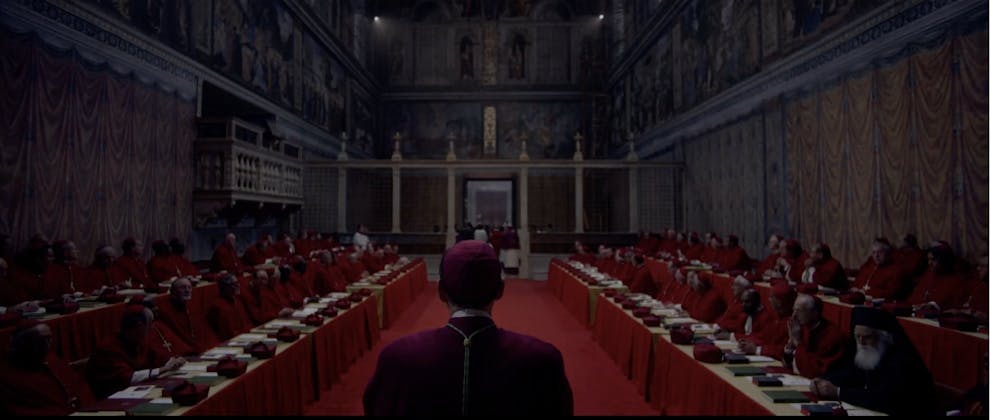“Conclave” is a fictitious account of the secretive selection process after a sitting pope passes away.
Cardinal Lawrence (Ralph Fiennes) is put in charge of holding and officiating the conclave ceremony. During this process, the cardinals of the Catholic Church from around the globe gathered to vote for who should be appointed as the new pope.
This supporting cast consists of Cardinal Bellini (Stanley Tucci), Cardinal Trembley (John Lithgow), Cardinal Adeyemi (Lucian Msamati), Cardinal Tradesco (Sergio Castellitto), and newly appointed Cardinal Benitez (Carlos Diehz), all of whom are vying for the papacy.
With help from Sister Agnes (Isabella Rossellini) and his assistant Monsignor O’Malley (Brían F. O’Byrne), Cardinal Lawrence begins to discover deep-rooted manipulation and controversy within the sacred walls.
Rather unexpectedly, the film was incredibly gripping. For a PG-rated film that follows the inner workings of the Catholic Church, it was surprisingly thought-provoking and emotionally deep.
This was partly due to the acting. Fiennes delivers yet another memorable and powerful performance that audiences are already accustomed to.
But the standout from the many supporting roles was Tucci, who somehow delivers the most brilliantly timed comedic lines as well as some of the most emotionally charged ones.
Although labeled as a drama and thriller, “Conclave” had the whole theater laughing at certain points. The dry humor was done incredibly well and really added some light notes to this film, which was rather dark.
With modern cinema becoming more genre-fluid, filmmakers are borrowing styles from multiple genres for a single film. Films like “Conclave” appreciate comedy and drama while offering tropes seen in horror and thriller films.
“Conclave” may very well be the best shot film of the year and showcases the narrative and tonal themes in the cinematography.
There is one scene in particular where all of the cardinals walk across a courtyard, all holding bright white umbrellas. This, contrasted with the scarlet garments worn by the clergymen involved in the conclave ceremony, adds such depth to a simple and purely aesthetically based shot.
The sound design was incredibly impactful, manipulating sounds to create certain moods and tones. For example, Fiennes’ breathing is emphasized when in silent environments, which adds to the raw human feel often portrayed in the film and the anxiety-inducing nature of the film itself.
Another example is the accentuated sounds of the church, such as a door opening, footsteps or a creaky floorboard. These sounds made you feel like you were with the characters at the conclave.
While “Conclave” offers the audience a nuanced view on the intersection of religion and politics, it also breathes fresh air into a stagnant movie industry. The movie industry is in a transformative process to escape the tropes and style that were so prevalent in the 2010s and earlier.
Berger will be a name we won’t forget in the years to come. He is leading the transformation towards genre-fluid filmmaking that I and any dedicated moviegoer will enthusiastically follow.
This article was edited by Alfie Pritchard, Marina Zaczkiewicz and Abigail Turner. Copy editing done by Emma Brown,Ariana Kavoossi and Charlie Mennuti.





